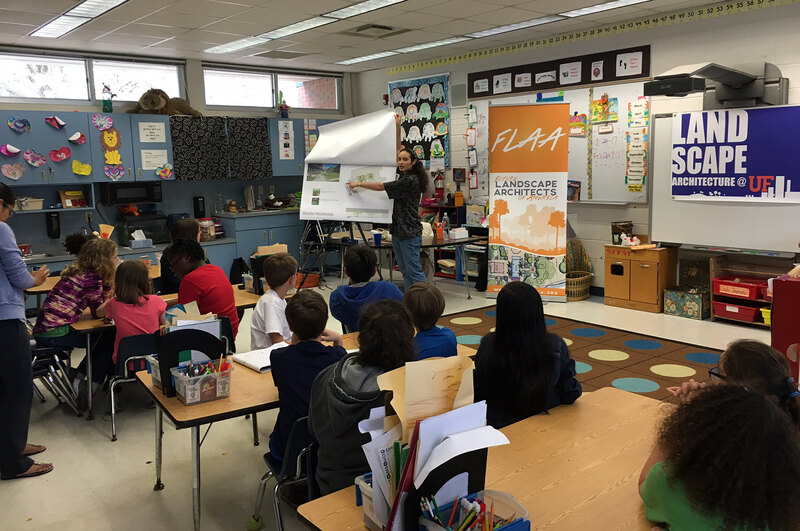Olmsted Scholar Feature: Rise of the Reading Garden

By Nathania Martinez, 2017 National Olmsted Scholar Finalist
Two years ago, Principal Valde Fortner from W.W. Irby Elementary School in Alachua, Florida, asked the University of Florida’s ASLA Student Chapter to design and build a “reading garden.” I participated in that effort, and today students and teachers enjoy the garden during class. The garden is also used for annual school events like Pop into a Good Book when parents join their children. I attended and saw parents smile with glee. Some found it hard to find time to read with their kids as often as they would like, and they were thrilled to have a space that encouraged them not only to make that time but to spend it outdoors.
The following summer I answered a call to volunteer to design another reading garden and lead a team of 17 volunteers to build it at Liberty City Elementary School in Miami, Florida. Here, I witnessed a diverse community come together to build a place where teachers and students could go to read and see colorful pollinators.
From these two projects, my curiosities about how children learn best have blossomed, and I wish to investigate whether reading gardens can inspire play that facilitates learning. While many teachers want to take their students outside, aside from lunch, physical education class, or lining up for the bus after school, children are spending most of the school day inside. My fondest childhood memories happened outdoors.

When designing for children we forget that they have ideas too — different ideas that we can learn from and be inspired by. They are not usually weighed down by practicalities, which results in some innovative ideas. I want to look to them for advice. I want to inform my practice by listening as they discover their thoughts, ideas, and perceptions about how the world works.
I am able to do this with the non-profit Future Landscape Architects of America and the University of Florida’s SCASLA advocacy team. We create lesson plans that introduce K-12 students to landscape architecture. When we ask them to brainstorm design ideas, I am always surprised at how well the children are able to communicate their needs and desires. As design professionals, we are rarely encouraged to seek advice from children. However, I want to recruit these minds to help me identify answers to my design questions. And I will look for inspiration from precedents like C. Th. Sørensen’s adventure playgrounds that foster free-spirited independent play, spark curiosity, and offer children opportunities to practice assessing risks and making decisions.
Principal Valde told me that a boy ran off one day to sit in one of the garden’s reading nooks to calm down after feeling upset. The space is not just for reading but also for respite and play. It is a space where multiple senses can be engaged to support children’s imaginations. In The Sense of Wonder, Rachel Carson wrote “many children delight in the small and inconspicuous.” It would be regrettable to not discover the little things in our early years, and discovery is best achieved beyond the confines of four walls.
The United Nations Article 31 of The Convention on the Rights of the Child recognizes play as a fundamental right of children. The term “reading garden” alludes to a space where the sole function seems to be a place that teachers take their pupils to read. I would like to stretch this beyond the possibly illusory belief that we can beguile our youth to read more if they do it outdoors, and to see it also as an offer of alternative environments for inquiry outside of students’ oftentimes windowless and poorly ventilated classrooms — a space where their stimulated senses can help to contribute to the stories their wondrous minds bring to life.
Nathania Martinez is a fifth year Bachelor Landscape Architecture student at the University of Florida and just completed an internship at the Landscape Architectural Accreditation Board (LAAB) in Washington, D.C.










